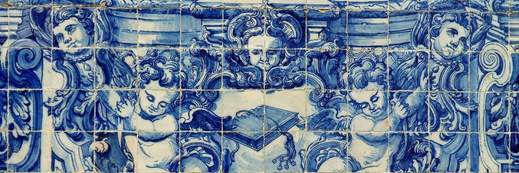When you travel to Portugal, you may well see public buildings, churches, monuments and even buildings or houses covered with tiles. These tiles have become, over time, one of the emblems of Portugal under the name of Azulejos.
2600 BC, the first earthenware tiles in Mesopotamia.
The first known glazed tiles (2600 BC) were found in Egypt and Mesopotamia. Then, they disappeared for a long time before the manufacturing technique was discovered in the 9th century and spread throughout the Arab world from Constantinople to Spain.

Palais Ishtar, Babylone
From the 15th century onwards, the whole of Europe, from Spain to Holland, Italy and France, used these earthenware tiles to decorate the most beautiful buildings.
16th century, the first azulejos in Portugal
At the beginning of the 16th century, King Manuel I imported the first Azulejos from Spain to cover the walls of the Palace that he had rebuilt in Sintra. These are the first Azulejos found in Portugal, but they were made in Spain.

Illustration : Palacio Nacional de Sintra, Crrdit : Hisour Art
Some time later, at the end of the 17th century, the Dutch reproduced the Chinese faience and focussed on tiles of earthenware with predominant blue and white.
The Portuguese then commissioned the Azulejos from the Dutch to decorate their palaces and churches. In Lisbon, for example, in the Madre de Deus Convent (Igreja do Convento da Madre de Deus), can be watched a beautiful scene made in Azulejos, painted in Holland by Jan van Oort and set up in 1698

Illustration : Igreja do Convento da Madre de Deus Lisboa
18th century, the Portuguese are the masters of the Azulejos
At the end of the 18th century, after the earthquake in Lisbon (1755), the Portuguese decided to use the technique of azulejos to rebuild the facades of their capital.
This choice is due to the low cost of manufacturing tiles and their ability to protect buildings from heat and humidity. The art of the Azulejos is then at its peak, the mastery of the painters of azulejos is such that they sign their creations.

Viuva Lamego Factory, Largo do intendente
The most beautiful Portuguese tiles
The church of Valega
This church is located in Ovar, near Aveiro. It was built in 1746, but its construction lasted more than a century. Today it is known as the "Portuguese Sistine Chapel". Its azulejos representing passages of the bible are considered as true masterpieces of the Baroque Art.

Igreja Matriz de Santa Maria, Valéga - Crédit : Wikimédia
The hall of coats of arms of the National Palace of Sintra
Residence of the Moorish Governor under Arab rule in the 10th century, the Sintra National Palace was then inhabited by the Portuguese Kings for nearly eight centuries.
The walls of the Palace were very early covered with Azulejos, most of which disappeared. It was King Manuel I who had the Azulejos imported from Seville at the beginning of the 16th century, covering a large part of the walls of the Palace. The famous Coats of Arms Hall is decorated with Azulejos panels dating from the 18th century.

Hall of coats of arms of the National Palace of Sintra
The Church of Saint Lawrence of Almancil in Faro
In Faro, the Church of St. Lawrence of Almancil in Faro, built in the 17th century is dedicated to St. Lawrence. It is a baroque style church whose interior is entirely covered with tiles depicting important moments in the life of the saint.

Eglise Saint Laurent d'Almancil
These unique azulejos were made in Lisbon around 1730 and then applied to the walls and the 6 arches of this church making it unique in the world.
São Bento station in Porto
The São Bento station, in downtown Porto, is recent and was put into service in 1896. It owes its name to the former convent of "São Bento de Avé Maria", which was destroyed to allow the construction of the station.

Hall of the lost steps of the station of são Bento
The Capela das Almas in Porto
The Capela das Almas is located in the heart of Porto. Built at the end of the 18th century, its external walls were covered with Azulejos only in 1929.

Capela das Almas de Santa Catarina
These tiles, painted by Eduardo Leite, were made by the ceramic factory Veuve Lamego, in Lisbon. They retrace, with 15947 tiles covering 360m2, the story of Saint Francis of Assisi and Saint Catherine.
You can find in our online store faithful reproductions of these figurative tiles. They are made by craftsmen usually responsible for the restoration of old tiles.
Azulejo anjo Barroco - Collection Luisa Paixão
The National Museum of Tiles in Lisbon.
If you are interested in the history of tiles, then a visit to the National Museum of Tiles is a must. This museum traces the history of Portuguese tiles from the 16th century to the present day.
The permanent exhibition will allow you to admire many tiles from different periods and thus understand the different manufacturing techniques and their evolution.
The azulejos, an art still alive in Portugal.
Even today, Azulejos are still used in decoration in their original form indeed, but they are more and more crafted with contemporary designs. They are present throughout Portugal but Lisbon metro stations and recent and very modern buildings such as Casa da Música in Porto are good examples of their decorative function.

Today, thanks to faithful reproductions, it is possible to enjoy the decorative interest of the Azulejos at home. By mounting them in azulejo murals for example
Azulejos mounted in fresco - Collection Luisa Paixão
or simply by placing them cleverly on the wall.
 Figurative azulejos - Collection Luisa Paixão
Figurative azulejos - Collection Luisa Paixão
And tomorrow?
Contemporary artists, craftsmen, continue to work with azulejos and invite themselves into street art, design, jewellery and kitchens.





